People have been living in Arizona for thousands of years. Each group had a different way of life. Every group settles the land in different ways and has beliefs about how they came to inhabit the earth. Esperanza’s describes American Indians in Chapter 13, page 126. (See below.)
“No, they were kind to me,” Carlos replied. “They made me part of their family. I am Nde. I pass my coming of age, received my name, and was given power. I am Nde.” He thumped his chest. “You don’t understand at all.”
Historian’s dates differ as to when the Apache or Ndé people entered the Southwestern part of the United States. Some believe the Apaches arrived about the same time as the Spanish explorers did in the 16th century; others think they arrived much earlier. The Apache homelands included the desert areas of Texas, New Mexico, Arizona and northern Mexico. The vast area inhabited by the Apache was known as Apacheria; the Chiricahua Apaches lived in the areas shown on the map below.
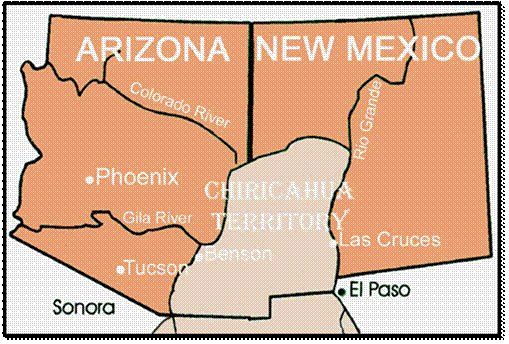
There are 13 different Apache tribes in the United States today with an approximate population of 57,000. There are five Apache tribes living in Arizona on three different reservations – the Tonto Apache Reservation, the White Mountain Apache Reservation and the San Carlos Apache Reservation. Apaches can choose to live on or off their reservations, of course. Today they live in houses and apartments like most Americans.
In the past, Apaches were a nomadic people, meaning they moved about frequently. Because of this, they built simple shelters that could be constructed quickly. Women were in charge of building small wickiups – teepee-like structures – made of wooden tree frames with a matting of brush or thatched grasses covering the frame. The circular or oval wickiups were about 8 to 12 feet in diameter and 6 to 9 feet tall. Typically, they didn’t spend much time in their wickiups because they were intended mainly for sleeping and storage. Possessions might have included a few kitchen tools – pans for cooking as well as baskets for gathering and storage and eating utensils.
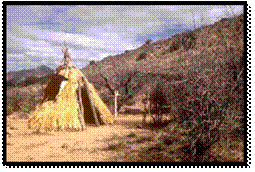
Apache wickiup near Fort Bowie
Apache men were hunters; they hunted buffalo, deer, antelope, rabbits and other small game. They didn’t eat bear, fish, frogs, snakes or pork, but considered horses, mules and cattle (beef) as the choicest meats. Women were gatherers of food – nuts, fruits, beans, seeds, and various cacti – and in charge of the home and children. Some Apache bands did grow corn, beans, melons and pumpkins; often they traded for the crops or sometimes raided others’ food supplies to obtain them.
Female Apache artists created beautiful basketry made of yucca or willow leaves and beautiful beadwork on clothing, footwear and other types of materials.
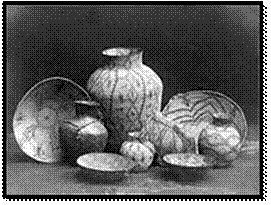
Apache Baskets
In the 1800s, Apaches adopted the clothing of neighboring peoples. The men wore cotton tunics and cotton pants with a breechcloth tied at the waist that hung almost to their knees and a headband tied around their shoulder-length hair. They also wore high deerskin boots or moccasins and shell jewelry; choker-style necklaces and ear-pendants were popular. (Read a description of Carlos and his appearance on page 101 in Esperanza Mans Hope.) Women wore short cotton skirts or buckskin dresses decorated with beading. They too, prized shell jewelry. Later, women wore calico dresses and skirts. Today, Apaches only wear their traditional clothing on special occasions.
All Apache children learned to ride horses and shoot arrows and boys enjoyed going fishing and hunting with their fathers. (Read p. 154 – 155 for a description of Carlos’ childhood with the Apaches.) Children had dolls and other toys (marbles). They competed in foot and horse races, wrestled, shot rocks with slings, played archery and games of jumping, tossing and hide-and-seek. Of course, there was also storytelling, dancing, and music as part of their cultural upbringing.
Children were never punished. Naming of infants occurred when something special was noticed about the child; Apaches could receive a different name as they grew older. (Read about how Carlos became Besh in Chapter 15.)
Apache spiritual beliefs were complex and varied among the different bands of Apaches. In general, though, Apaches believed that supernatural forces or powers existed in their natural surroundings and that, at one time, the Apache people lived among the supernatural beings. They believed that these forces or powers could be used to serve individuals. Sometimes an individual sought after the power, but sometimes the powers were thrust upon the individual. In the story, Besh or Carlos, is struck by lightening and survived after which, he is considered to have lightening power. (Re-read pp.140 and 177-178.)
Ussen (or Usen), the Creator god or Life Giver, was an important deity. The Apache, like most cultures, told a creation and flood story. There were four sacred colors attached to the creation story – black, blue, yellow, and white – that guided the Apaches in their prayer to the Creator. The four colors symbolized the colors of the threads Tarantula used to pull and stretch the earth. During creation, the Creator made the gods, heavens, earth, plants, and animals all from his sweat.
Apaches also commonly believe that spirits live within certain mountains and other underground places. Part of the Apache creation story introduces the belief that they are the blood relatives of the mountains, trees, rocks, and the wind. Dzil Nchaa Si An (Mt. Graham) is known to this day as the home of the Ga’an or Mountain Spirits.
A “shaman” was a religious leader who had the power to heal. The Apache people were familiar with healing herbs and plants that they prepared and used as medicines. Ussen, had originally taught the Apaches how to heal with plants, and each following generation had men who were skilled in the ancient art of healing. Prayers and incantations were involved in the process of preparation and application of the medicines. (Read about Carlos’ experience with a healing ceremony on pages 170–171.)
The Chiricahua Apaches whose homelands included the Cochise County area of Arizona, New Mexico and northern Mexico were involved in the Apache Wars central to Esperanza’s story. Two leaders, Cochise and Geronimo, were important historical players in the interactions between the Apaches, Mexicans and Anglos. Cochise was a chief of the Chokonen band of Chiricahua and Geronimo was a fierce warrior of the Bedonkohe band of the Chiricahua; both are known for their resistance against the U.S. military.
Apache children played games that kept them physically fit with a keen mental awareness. Archery was an important competition sport, as the bow and arrow was their main weapon. Apache kids also played toe and toss games to develop coordination, balance, and strength. They ran up mountain trails for fitness every day and were skilled in running long distances.
Toe Toss Stick: To play this game, a stick is needed. To set up play, make a mark on the ground with the stick. Then stand behind the mark and balance the stick on your toe. The object is to toss the stick as high as you can and have it land on the mark. Points for height and for accuracy are awarded.
Foot Toss Ball: To play this game, a stone is needed. To set up play, balance the stone on your toes. This game had a choice. Players could see how far each player could toss the stone or how high each could toss the stone with their toes. Kids used light stones, adults used heavy stones, and they completed with each other.
Kah: Two teams play a game that is sort of like hide-and-seek. While one team is singing, the other team hides a bone in a one of four moccasins that are partially buried in the ground. If the singing team guesses which moccasin the bone is in, the team wins a point and gets to sing and search again. When the singing team guesses incorrectly, the hiding team gets to take their turn to sing and search. The team with the most points, counted using sticks, wins the game.
Hoop and Pole Game: Two players play the game. Basically a hoop or disk is rolled along the ground, and poles, javelins, or arrows are thrown at the rolling target. The object is to stop the hoop, causing poles to lie in or
on the hoop. Scores are determined by the positions of the poles with respect to the ring.
![]()
![]()
![]()
![]()
![]()
![]()
![]()
![]()
![]()
![]()
![]()
![]()
![]()
![]()
![]()
![]()
![]()
![]()
![]()
![]()
![]()
![]()
![]()
![]()
![]()
![]()
![]()
![]()
![]()
![]()
![]()
![]()
![]()
![]()
![]()
![]()
![]()
![]()
![]()
![]()
![]()
![]()
![]()
![]()
![]()
![]()
![]()
![]()
![]()
![]()
![]()
![]()
![]()
![]()
![]()
![]()
![]()
![]()
![]()
![]()
![]()
![]()
![]()
![]()
![]()
![]()
![]()
![]()
![]()
![]()
![]()
![]()
![]()
![]()
![]()
![]()
![]()
![]()
![]()
![]()
![]()
![]()
![]()
![]()
![]()
![]()
![]()
![]()
![]()
![]()
![]()
![]()
![]()
![]()
![]()
![]()
![]()
![]()
![]()
![]()
![]()
![]()
![]()
![]()
![]()
![]()
![]()
![]()
![]()
![]()
![]()
![]()
![]()
![]()
![]()
![]()
![]()
![]()
![]()
![]()
![]()
![]()
![]()
![]()
![]()
![]()
![]()
![]()
![]()
![]()
![]()
![]()
![]()
![]()
![]()
![]()
![]()
![]()
![]()
![]()
![]()
![]()
![]()
![]()
In the first days a powerful being named Humpback owned all the buffalo. He kept them in a corral in the mountains north of San Juan, where he lived with his young son. Not one buffalo would Humpback release for the people on earth, nor would he share any meat with those who lived near him.Coyote decided that something should be done to release the buffalo from Humpback’s corral. He called the people to a council. “Humpback will not give us any buffalo,” Coyote said. “Let us all go over to his corral and make a plan to release them.”
They camped in the mountains near Humpback’s place, and after dark they made a careful inspection of his buffalo enclosure. The stonewalls were too high to climb, and the only entrance was through the back door of Humpback’s house.
After four days Coyote summoned the people to another council, and asked them to offer suggestions for releasing the buffalo. “There is no way,” said one man. “To release the buffalo we must go into Humpback’s house, and he is too powerful a being for us to do that.”
“I have a plan,” Coyote said. “For four days we have secretly watched Humpback and his young son go about their daily activities. Have you not observed that the boy does not own a pet of any kind?”
The people did not understand what this had to do with releasing the buffalo, but they knew that Coyote was a great schemer and they waited for him to explain. “I shall change myself into a killdeer,” Coyote said. “In the morning when Humpback’s son goes down to the spring to get water, he will find a killdeer with a broken wing. He will want this bird for a pet and will take it back into the house. Once I am in the house I can fly into the corral, and the cries of a killdeer will frighten the buffalo into a stampede. They will come charging out through Humpback’s house and be released upon the earth.”
The people thought this was a good plan, and the next Morning when Humpback’s son came down the path to the spring he found a killdeer with a crippled wing. As Coyote had foreseen, the boy picked up the bird and carried it into the house.
“Look here,” the boy cried. “This is a very good bird!”
“It is good for nothing!” Humpback shouted. “All the birds and animals and people are rascals and schemers.” Above his fierce nose Humpback wore a blue mask, and through its slits his eyes glittered. His basket headdress was shaped like a cloud and was painted black with a zig-zag streak of yellow to represent lightning. Buffalo horns protruded from the sides.
“It is a very good bird,” the boy repeated.
“Take it back where you found it!” roared Humpback, and his frightened son did as he was told.
As soon as the killdeer was released it returned to where the people were camped and changed back to Coyote. “I have failed,” he said, “but that makes no difference. I will try again in the morning. Perhaps a small animal will be better than a bird.”
The next morning when Humpback’s son went to the spring, he found a small dog there, lapping at the water. The boy picked up the dog at once and hurried back into the house. “Look here!” he cried. “What a nice pet I have.”
“How foolish you are, boy!” Humpback growled. “A dog is good for nothing. I’ll kill it with my club.”
The boy held tight to the dog, and started to run away crying.
“Oh, very well,” Humpback said. “But first let me test that animal to make certain it is a dog. All animals in the world are schemers.” He took a coal of fire from the hearth and brought it closer and closer to the dog’s eyes until it gave three rapid barks. “It is a real dog,” Humpback declared. “You may keep it in the buffalo corral, but not in the house.”
This of course was exactly what Coyote wanted. As soon as darkness fell and Humpback and his son went to sleep, Coyote opened the back door of the house. Then he ran among the buffalo, barking as loud as he could. The buffalo were badly frightened because they had never before heard a dog bark. When Coyote ran nipping at their heels, they stampeded toward Humpback’s house and entered the rear door. The pounding of their hooves awakened Humpback, and although he jumped out of bed and tried to stop them, the buffalo smashed down his front door and escaped.
After the last of the shaggy animals had galloped away, Humpback’s son could not find his small dog. “Where is my pet?” he cried. “Where is my little dog?”
“That was no dog,” Humpback said sadly. “That was Coyote the Trickster. He has turned loose all our buffalo.”
Thus it was that the buffalo were released to scatter over all the earth.
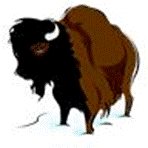

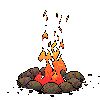

Long, long ago, animals and trees talked with each other, but there was no fire at that time.Fox was most clever and he tried to think of a way to create fire for the world. One day, he decided to visit the Geese, te-tl, whose cry he wished to learn how to imitate. They promised to teach him if he would fly with them. So they contrived a way to attach wings to Fox, but cautioned him never to open his eyes while flying.
Whenever the Geese arose in flight, Fox also flew along with them to practice their cry. On one such adventure, darkness descended suddenly as they flew over the village of the fireflies, ko-na- tcic-a. In midflight, the glare from the flickering fireflies caused Fox to forget and he opened his eyes–instantly his wings collapsed! His fall was uncontrollable. He landed within the walled area of the firefly village, where a fire constantly burned in the center.
Two kind fireflies came to see fallen Fox, who gave each one a necklace of juniper berries, katl-te-i-tse.
Fox hoped to persuade the two fireflies to tell him where he could find a way over the wall to the outside. They led him to a cedar tree, which they explained would bend down upon command and catapult him over the wall if he so desired.
That evening, Fox found the spring where fireflies obtained their water. There also, he discovered colored earth, which when mixed with water made paint. He decided to give himself a coat of white. Upon returning to the village, Fox suggested to the fireflies, “Let’s have a festival where we can dance and I will produce the music.”
They all agreed that would be fun and helped to gather wood to build up a greater fire. Secretly, Fox tied a piece of cedar bark to his tail. Then he made a drum – probably the first one ever constructed, and beat it vigorously with a stick for the dancing fireflies. Gradually, he moved closer and closer to the fire.
Fox pretended to tire from beating the drum. He gave it to some fireflies that wanted to help make the music. Fox quickly thrust his tail into the fire, lighting the bark, and exclaimed, “It is too warm here for me, I must find a cooler place.”
Straight to the cedar tree Fox ran, calling, “Bend down to me, my cedar tree, bend down!”
Down bent the cedar tree for Fox to catch hold, then up it carried him far over the wall. On and on he ran, with the fireflies in pursuit.
As Fox ran along, brush and wood on either side of his path were ignited from the sparks dropping from the burning bark tied to his tail.
Fox finally tired and gave the burning bark to Hawk, i-tsarl-tsu-i, who carried it to brown Crane, tsi-nes-tso-l. He flew far southward scattering fire sparks everywhere. This is how fire first spread over the earth.
Fireflies continued chasing Fox all the way to his burrow and declared, “Forever after, Wily Fox, your punishment for stealing our fire will be that you can never make use of it for yourself.”
For the Apache nation, this too was the beginning of fire for them. Soon they learned to use it for cooking their food and to keep themselves warm in cold weather.


Animals, elements, the solar system, and nature are revered by the Apaches. That which is beyond their understanding is always recognized as the supernatural. In the beginning nothing existed–no earth, no sky, no sun, no moon, only darkness was everywhere.Suddenly from the darkness emerged a thin disc, one side yellow and the other side white, appearing suspended in midair. Within the disc sat a small bearded man, Creator, the One Who Lives Above. As if waking from a long nap, he rubbed his eyes and face with both hands.
When he looked into the endless darkness, light appeared above. He looked down and it became a sea of light. To the east, he created yellow streaks of dawn. To the west, tints of many colors appeared everywhere. There were also clouds of different colors.
Creator wiped his sweating face and rubbed his hands together, thrusting them downward. Behold! A shining cloud upon which sat a little girl.
“Stand up and tell me where are you going,” said Creator. But she did not reply. He rubbed his eyes again and offered his right hand to the Girl-Without-Parents.
“Where did you come from?” she asked, grasping his hand.
“From the east where it is now light,” he replied, stepping upon her cloud.
“Where is the earth?” she asked.
“Where is the sky?” he asked, and sang, “I am thinking, thinking, thinking what I shall create next.” He sang four times, which was the magic number.
Creator brushed his face with his hands, rubbed them together, then flung them wide open! Before them stood Sun-God. Again Creator rubbed his sweaty brow and from his hands dropped Small- Boy.
All four gods sat in deep thought upon the small cloud.
“What shall we make next?” asked Creator. “This cloud is much too small for us to live upon.”
Then he created Tarantula, Big Dipper, Wind, Lightning-Maker, and some western clouds in which to house Lightning-Rumbler, which he just finished.
Creator sang, “Let us make earth. I am thinking of the earth, earth, earth; I am thinking of the earth,” he sang four times.
All four gods shook hands. In doing so, their sweat mixed together and Creator rubbed his palms, from which fell a small round, brown ball, not much larger than a bean.
Creator kicked it, and it expanded. Girl-Without-Parents kicked the ball, and it enlarged more. Sun-God and Small-Boy took turns giving it hard kicks, and each time the ball expanded. Creator told Wind to go inside the ball and to blow it up.
Tarantula spun a black cord and, attaching it to the ball, crawled away fast to the east, pulling on the cord with all his strength. Tarantula repeated with a blue cord to the south, a yellow cord to the west, and a white cord to the north. With mighty pulls in each direction, the brown ball stretched to immeasurable size–it became the earth! No hills, mountains, or rivers were visible; only smooth, treeless, brown plains appeared.
Creator scratched his chest and rubbed his fingers together and there appeared Hummingbird.
“Fly north, south, east, and west and tell us what you see,” said Creator.
“All is well,” reported Hummingbird upon his return. “The earth is most beautiful, with water on the west side.”
But the earth kept rolling and dancing up and down. So Creator made four giant posts–black, blue, yellow, and white to support the earth. Wind carried the four posts, placing them beneath the four cardinal points of the earth. The earth sat still.
Creator sang, “World is now made and now sits still,” which he repeated four times.
Then he began a song about the sky. None existed, but he thought there should be one. After singing about it four times, twenty- eight people appeared to help make a sky above the earth. Creator chanted about making chiefs for the earth and sky.
He sent Lightning-Maker to encircle the world, and he returned with three uncouth creatures, two girls and a boy found in a turquoise shell. They had no eyes, ears, hair, mouths, noses, or teeth. They had arms and legs, but no fingers or toes.
Sun-God sent for Fly to come and build a sweathouse. Girl- Without-Parents covered it with four heavy clouds. In front of the east doorway she placed a soft, red cloud for a foot-blanket to be used after the sweat.
Four stones were heated by the fire inside the sweathouse. The three uncouth creatures were placed inside. The others sang songs of healing on the outside, until it was time for the sweat to be finished. Out came the three strangers who stood upon the magic red cloud-blanket. Creator then shook his hands toward them, giving each one fingers, toes, mouths, eyes, ears, noses and hair.
Creator named the boy, Sky-Boy, to be chief of the Sky-People. One girl he named Earth-Daughter, to take charge of the earth and its crops. The other girl he named Pollen-Girl, and gave her charge of health care for all Earth-People.
Since the earth was flat and barren, Creator thought it fun to create animals, birds, trees, and a hill. He sent Pigeon to see how the world looked. Four days later, he returned and reported, “All is beautiful around the world. But four days from now, the water on the other side of the earth will rise and cause a mighty flood.”
Creator made a very tall pinon tree. Girl-Without-Parents covered the tree framework with pinon gum, creating a large, tight ball.
In four days, the flood occurred. Creator went up on a cloud, taking his twenty-eight helpers with him. Girl-Without-Parents put the others into the large, hollow ball, closing it tight at the top.
In twelve days, the water receded, leaving the float-ball high on a hilltop. The rushing floodwater changed the plains into mountains, hills, valleys, and rivers. Girl-Without-Parents led the gods out from the float-ball onto the new earth. She took them upon her cloud, drifting upward until they met Creator with his helpers, who had completed their work making the sky during the flood time on earth.
Together the two clouds descended to a valley below. There, Girl- Without-Parents gathered everyone together to listen to Creator.
“I am planning to leave you,” he said. “I wish each of you to do your best toward making a perfect, happy world.
“You, Lightning-Rumbler, shall have charge of clouds and water.
“You, Sky-Boy, look after all Sky-People.
“You, Earth-Daughter, take charge of all crops and Earth-People.
“You, Pollen-Girl, care for their health and guide them.
“You, Girl-Without-Parents, I leave you in charge over all.”
Creator then turned toward Girl-Without-Parents and together they rubbed their legs with their hands and quickly cast them forcefully downward. Immediately between them arose a great pile of wood, over which Creator waved a hand, creating fire.
Great billowy clouds of smoke at once drifted skyward. Into this cloud, Creator disappeared. The other gods followed him in other clouds of smoke, leaving the twenty-eight workers to people the earth.
Sun-God went east to live and travel with the Sun. Girl-Without- Parents departed westward to live on the far horizon. Small-Boy and Pollen-Girl made cloud homes in the south. Big Dipper can still be seen in the northern sky at night, a reliable guide to all.
Now, one day after Earth-Maker shaped the world, Iioi, our Elder Brother was sitting and watching the children play. He saw the joy and the youthfulness they displayed. He saw the beauty of their surroundings, and the fresh fragrance of the trees and the flowers. He heard the happy songs of the birds, and saw the blue of the sky. He saw the women as they ground cornmeal. He saw their beauty, and the sunlight as it shone from their hair. These were wonderful things.
But then Elder Brother realized that all of these things would change. He knew that these children would all grow old and weaken and die. The beautiful women would someday grow fat and ugly, and their beautiful black hair would turn gray. The leaves would turn brown and fall from the trees, and the beautiful flowers that smelled so fresh would fade. The days would grow short and the nights would be cold. Elder Brother’s heart grew sad and troubled.
As Elder Brother watched the women grind cornmeal, the wind made some fallen yellow leaves dance in the sunlight. He decided to do something that would capture some of these wonderful things that He saw. He decided that He must make something that everyone could enjoy, that would lift their hearts and spirits. So, He took out His bag of Creation and began to gather some things together.
He took some blue from the sky, and some whiteness from the cornmeal. He gathered some spots of sunlight, and the blackness of a beautiful woman’s hair. He took the yellow of the falling leaves, and the green of the pine needles. He gathered the red, the purple, and the orange from the flowers. As He gathered these things, He put them into His bag. And, last, He put the songs of the songbirds in the bag.
When He had finished gathering these things together, He called the children together. He told them to open the bag and there would be surprises for them. So they opened the bag, and out flew hundreds of beautiful Butterflies! They were red and gold and black and yellow, blue and green and white. They looked liked flowers, dancing in the wind. They flew all around the gleeful children, and lit on their heads. The hearts of the children and the adults soared. Never before had they seen such wonderful, happy things. They began to sing their songs as they flew.
But then songbird lit on Iitoi’s shoulder and asked Him. He said, “It is not right to give our songs to these pretty things! You told us when you made us that each bird would have his own song. These pretty things have all of the colors of the rainbow already. Must they take our songs, too?”
Elder Brother said, “You are right. I made one song for each bird, and I must not give them away to any other.” So butterflies were made silent, and they are still silent to this day. But their beauty brightens the day of all People, and brings out songs from their hearts.


A long time ago the Bluebird’s feathers were a very dull ugly color. It lived near a lake with waters of the most delicate blue that never changed because no stream flowed in or out.
Because the bird admired the blue water, it bathed in the lake four times every morning for four days, and every morning it sang, “There’s a blue water. It lies there. I went in. I am all blue.”
On the fourth morning it shed all its feathers and came out in its bare skin, but on the fifth morning it came out with blue feathers.
All the while, Coyote had been watching the bird. He wanted to jump in and catch it for his dinner, but he was afraid of the blue water.
But on the fifth morning he said to the Bluebird, “How is it that all your ugly color has come out of your feathers, and now you are all blue and sprightly and beautiful? You are more beautiful than anything that flies in the air. I want to be blue, too.”
“I went in only four times,” replied the Bluebird.
It then taught Coyote the song it had sung. And so Coyote steeled his courage and jumped into the lake. For four mornings he did this, singing the song the Bluebird had taught him, and on the fifth day he turned as blue as the bird. This made Coyote feel very proud. He was so proud to be a blue coyote that when he walked along he looked about on every side to see if anyone was noticing how fine and blue he was.
Then he started running along very fast, looking at his shadow to see if it also was blue. He was not watching the road, and presently he ran into a stump so hard that it threw him down upon the ground and he became dust-colored all over.
And to this day all coyotes are the color of dusty earth.
| Research information and/or read biographies about Cochise or Geronimo. Produce a mini-documentary about the two leaders or write a bio-poem for them. You could also research other Apache leaders such as Mangas Colorades (father-in-law of Cochise). | Learn more about the Apache Trail and learn about traveling the Apache Trail. Make a map of the Apache Trail and include specific locations of interest on your map. What did President Roosevelt say about the trail? |
Read through the directions for playing Apache Games. Then join with another student or students to play each of the games. Explain orally which game you liked best and why. Keep score and explain how you decided the winners. |
| Read Geronimo’s story in his own words. Compare his story autobiography with other versions of his life told from others’ perspectives. | Research the Papago (Rosa in the story was Papago) or Tohono O’odham people. Make a six part foldable and include the following information categories about them: homelands, history, foods, shelter, clothing, and famous people. | Watch videos about the Apaches from Discovery Education’s collections located at ADE’s Ideal website. Your teacher has a list of the best videos to watch. As you watch the clips write down 10 new things you learned about the Apaches based on the videos. |
| Read the Apache and/or the Papago legends. Draw a picture or series of pictures to illustrate the legends. Understand and respect the practice of Native Americans only telling certain stories at a particular time of the year or for a specific ceremony or celebration. | Learn more about Native American medicines and which plants they used to heal. The “shaman” also used special ceremonies to heal. Find and re-read the pages in the book Carlos and others used native plants to heal. Share what you learned in a poster or PowerPoint show. | Use the beadwork generator to make a colorful sampler of beadwork. Print a colored copy and post it.
Watch the slideshow about how to build a wickiup. Can you make a small model of it using the steps shown? |